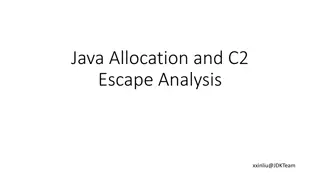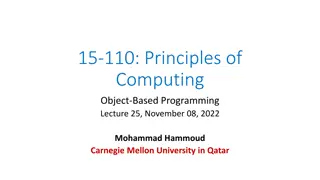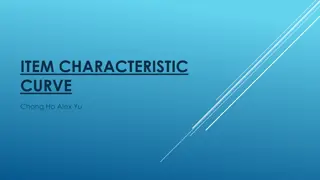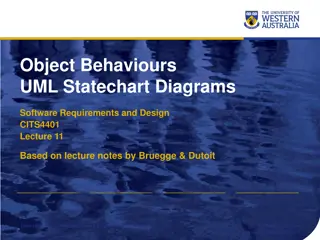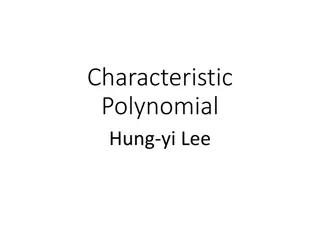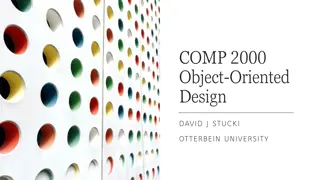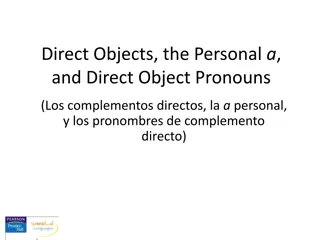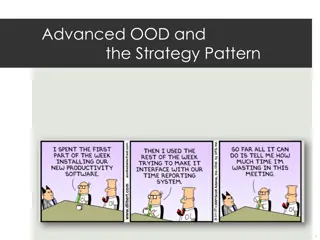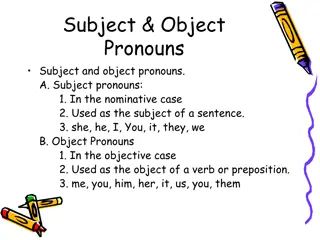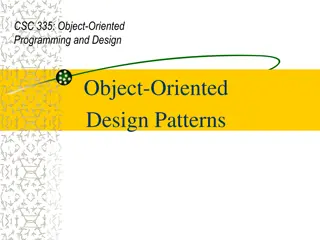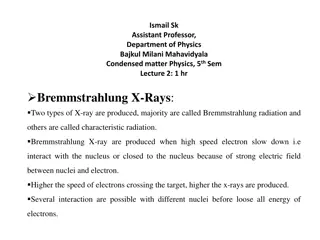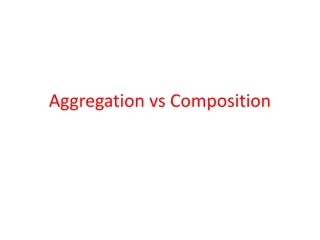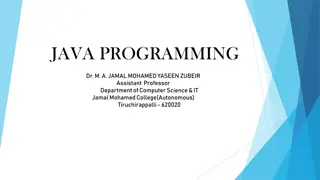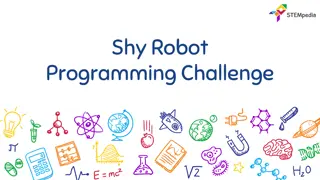
Object-Oriented Programming Concepts
Explore the foundational concepts of object-oriented programming, such as abstraction, encapsulation, and modularity. Learn how these principles shape the way we approach problem-solving in IT projects and develop a solid understanding of Object-Oriented (OO) concepts, including objects, operations, attributes, relationships, and more.
Download Presentation

Please find below an Image/Link to download the presentation.
The content on the website is provided AS IS for your information and personal use only. It may not be sold, licensed, or shared on other websites without obtaining consent from the author. If you encounter any issues during the download, it is possible that the publisher has removed the file from their server.
You are allowed to download the files provided on this website for personal or commercial use, subject to the condition that they are used lawfully. All files are the property of their respective owners.
The content on the website is provided AS IS for your information and personal use only. It may not be sold, licensed, or shared on other websites without obtaining consent from the author.
E N D
Presentation Transcript
Objectives Understand how OO affects the BA role on IT projects. Understand key OO concepts: Objects Operations and attributes Encapsulation Classes Entity classes Relationships Generalization Association Aggregation Composite aggregation Polymorphism System use cases Business use cases Unified Modeling Language (UML)
Each of these styles of programming is based on its own conceptual framework. Each requires a different mindset, a different way of thinking about the problem. For all things object-oriented, the conceptual framework is the object model. There are four major elements of this model : 1. Abstraction 2. Encapsulation 3. Modularity 4. Hierarchy There are three minor elements of the object model: 1. Typing 2. Concurrency 3. Persistence
Abstraction An abstraction denotes the essential characteristics of an object that distinguish it from all other kinds of objects and thus provide crisply defined conceptual boundaries, relative to the perspective of the viewer. Abstraction is one of the fundamental ways that we as humans cope with complexity. Dahl, Dijkstra, and Hoare suggest that abstraction arises from a recognition of similarities between certain objects, situations, or processes in the real world, and the decision to concentrate upon these similarities and to ignore for the time being the differences [42]. Shaw defines an abstraction as a simplified description, or specification, of a system that emphasizes some of the system s details or properties while suppressing others. A good abstraction is one that emphasizes details that are significant to the reader or user and suppresses details that are, at least for the moment, immaterial or diversionary [43]. Berzins, Gray, and Naumann recommend that a concept qualifies as an abstraction only if it can be described, understood, and analyzed independently of the mechanism that will eventually be used to realize it [44].
Encapsulation Encapsulation is the process of compartmentalizing the elements of an abstraction that constitute its structure and behavior; encapsulation serves to separate the contractual interface of an abstraction and its implementation. Abstraction and encapsulation are complementary concepts: Abstraction focuses on the observable behavior of an object, whereas encapsulation focuses on the implementation that gives rise to this behavior. Encapsulation is most often achieved through information hiding (not just data hiding), which is the process of hiding all the secrets of an object that do not contribute to its essential characteristics; typically, the structure of an object is hidden, as well as the implementation of its methods.
Modularity/Decomposition Modularity is the property of a system that has been decomposed into a set of cohesive and loosely coupled modules. Modularization consists of dividing a program into modules which can be compiled separately, but which have connections with other modules. The act of partitioning a program into individual components can reduce its complexity to some degree. . . . Although partitioning a program is helpful for this reason, a more powerful justification for partitioning a program is that it creates a number of well-defined, documented boundaries within the program. These boundaries, or interfaces, comprehension of the program are invaluable in the
Thus, encapsulation, and modularity are synergistic. An object provides a crisp boundary around a single abstraction, and both encapsulation and modularity provide abstraction. the principles of abstraction, barriers around this
Hierarchy Hierarchy abstractions. The two most important hierarchies in a complex system are its class structure the is a hierarchy) and its object structure (the part of hierarchy). is a ranking or ordering of
Typing Typing is the enforcement of the class of an object, such that objects of different types may not be interchanged, or at the most, they may be interchanged only in very restricted ways. Typing lets us express our abstractions so that the programming language implement them can be made to enforce design decisions. in which we
Concurency Concurrency is the property that distinguishes an active object from one that is not active. For certain kinds of problems, an automated system may have to handle many different events simultaneously. Other problems may involve so much computationthat they exceed the capacity of any single processor. In each of these cases, it is natural to consider using a distributed set of computers for the target implementationor to use multitasking. A single process is the root from which independent dynamic action occurs within a system. Every program has at least one thread ofcontrol, but a system involving concurrency may have many such threads: some that are transitory and others that last the entire lifetime of the system s execution.
Persistence Persistence is the property of an object through which its existence transcends time (i.e., the object continues to exist after its creator ceases to exist) and/orspace (i.e., the object s location moves from the address space in which it was created). Persistence deals with more than just the lifetime of data. In object-oriented databases, not only does the state of an object persist, but its class must also transcend any individual program, so that every program interprets this saved state in the same way. This clearly makes it challenging to maintain the integrity of a database as it grows, particularly if we must change the class of an object.
Why Object Objects are easier for people to understand: This is because the objects are derived from the business that we re trying to automate, rather than being influenced too early by computer- based procedures or data storage requirements. For example, in a bank system, we program in terms of bank accounts, bank tellers and customers, instead of account records, deposit procedures, and loan qualificationalgorithms. diving straight withdrawal into and
Specialists can communicate better: Over time, the software industry has constructed career ladders that newcomers are expected to climb gradually experience increases. Typically, the first rung is programmer: fixing faults (bugs) in the code written by others. The second rung is senior programmer: writing the code itself. The third is designer: deciding what code needs to be written. Finally comes the role of analyst: talking to customers to discover what they need and then writing down a specification of what the finished system must be able to do. as their knowledge and
Data and processes are not artificially separated: In traditional methods, the data that needs to be stored is separated early on from the algorithms that operate on that data and they are then developed independently. This can result in the data being in inconvenient formats or inconvenient locations, with respect to the processes that need access. With object oriented development, data and processes are kept together in small, easy-to-manage packages; data is never separated from the algorithms. We also end up with less complex code that is less sensitive to changes in customer requirements.
Code can be reused more easily: With the traditional approach, we start with the problem that needs to be solved and allow that problem to drive the entire development. We end up with a monolithic solution to today s problem. But tomorrow always brings a different problem to solve; no matter how close the new problem is to the last one we dealt with, we re unlikely to be able to break open our monolithic system and make it fit. Object orientation is mature and well proven: This is not a new fad. The programming concepts emerged in the late 1960s while the methodologies have been around for at least a decade. Applying objects in such areas as software, databases and understood. networks is now well
A model is a representation of a problem domain or a proposed solution that allows us to about the real thing. This allows us to increase our understanding and avoid potential pitfalls. Think of an architect s model of a new concert hall: it allows the architects say This is what the finished concert hall will look like and it helps them to come up with new ideas, such as I think we re going to need a steeper roof . A model allows us to learn a without actually building anything. Much of software creating and refining models, rather than cutting lines of code. talk, or reason, development involves
From the perspective of human cognition, an object is any of the following: A tangible and/or visible thing Something that may be comprehended intellectually Something toward which thought or action is directed An object is an entity that has state, behavior, and identity. The structure and behavior of similar objects are defined in their common class. The terms instance and object are interchangeable.
Object All objects have attributes: for example, a car has a manufacturer, a model number, a color and a price; a dog has a breed, an age, a color and a favorite toy. Objects also have behavior: a car can move from one place to another and a dog can bark. In object-oriented software, real world objects migrate into the code. In programming terms, our objects become stand- alone modules with their own knowledge and behavior (or, if you prefer, their own data and processes). It s common to think of a software object as a robot, an animal, or a little person: each object has certain knowledge, in the form of attributes, and it knows how to perform certain operations for the benefit of the rest of the program. For example, a person object might know its title, first name, last name, date of birth and address; it would be able to change its name, move to a new address,, and so on.
Classes A class is a set of objects that share a common structure, common behavior, semantics. A single object is simply an instance of a class. A class is a category. All objects that belong to the same category have the same attributes and operations (but the values of the attributes may change from object to object). and common
When designing a class hierarchy, you should bear in mind that most superclasses are abstract. This follows from the fact that inheritance hierarchies are naturally derived from the bottom up: 1. We look for the concrete concepts that exist in our problem domain and reason about their knowledge and behavior. 2. We look for commonalities between the concrete classes so that we can superclasses. 3. We group superclasses into more superclasses, until we arrive at our most general root class (Fruit or Collection, for example). introduce more general
Relationship The encompasses the assumptions that each makes about the other, including what operations can be performed and what behavior results. We have found that two kinds of object relationships are of particular interest in object-oriented analysis and design, namely: 1. Links, denote peer-to-peer or client/supplier relationships 2. Aggregation, denotes a whole/part hierarchy, with the ability to navigate from the whole (also called the aggregate) to its parts. In this sense, aggregation is a specialized kind of association relationship between any two objects
Generalization The concept of a class allows us to make statements about a set of objects that we treat exactly the same way. But sometimes we run into objects that are only partially alike. For example, we may own a store that has a number of iPhone 5 objects and a number of Samsung SIII phone objects. The iPhone 5 are not exactly like the Samsung SIII phones, but they do share some characteristics for example, the ability to place a mobile call.
A generalization is a taxonomic relationship between a more general classifier and a more specific classifier. Each instance of the specific classifier is also an indirect instance of the general classifier. Thus, the specific classifier inherits the features of the more general classifier. When an object belongs to a specialized class (for example, iPhone 3G), this automatically implies that it belongs to a generalization of that class (for example, Mobile Phone).Any attribute or operation that applies to the generalized class also applies to the specialized class. Furthermore, any relationships generalized class also apply to the specialized class. specified for the
What is Generalization? One class inherits from another GroundVehicle Person owner ancestor weight licenseNumber 0..* 1 register( ) generalization Trailer Truck Car decendent size tonnage getTax( )
Association An association specifies a semantic relationship that can occur between typed instances. An instance of an association is called a link An association between two classes indicates that objects (instances) of one class may be related (linked) to objects of the other class. You specify an association at the class level; you specify a link at the object level.
Association Association is a weak form of connection: the objects may be part of a group, or family, of objects but they re not completely dependent on each other. For example, consider a car, a driver, a passenger and another passenger. When the driver and the two passengers are in the car, they re associated: they all go in the same direction, they occupy the same volume in space, and so on. But the association is loose: the driver can drop off one of the passengers to go their separate way, so that the passenger is no longer associated with the other objects. Figure 2.5 shows how we can draw an association on an object diagram the attributes and operations have been omitted here in order to emphasize the structure.
Aggregation Aggregation: A special form of association that specifies a whole-part relationship between the aggregate (whole) and a component part. Formally, in the UML, aggregation is considered to be a specific type of association, where the class on one end of the association represents a whole and the class at the other end represents a part. Aggregation may be used by the BA as an alternative to modeling an association with the name is a part of .
Aggregation Aggregation means putting objects together to make a bigger object. Manufactured items usually form aggregations: for example, a microwave is made up of a cabinet, a door, an indicator panel, buttons, a motor, a glass plate, a magnetron, and so on. Aggregations usually form a part whole hierarchy. Aggregation implies close dependency, at least of hewhole to the part; for example, a magnetron is still a magnetron if you take it out of its microwave, but the microwave would be useless without the magnetron, because it wouldn t be able to cook anything.
Composition Aggregation Composite aggregation, also known as composition, is a special form of aggregation where in each part may belong to only one whole at a time. Composite aggregation is a strong form of aggregation that requires a part instance be included in at most one composite at a time. If a composite is deleted, all of its parts are normally deleted with it. Formally, composition is a specific kind of aggregation. In aggregation, a part may belong to more than one whole at the same time; in composite aggregation, however, the object may belong to only one whole at a time. The parts are destroyed whenever the whole is destroyed except for those parts that have been removed prior to the deletion of the whole.
Inheritance Inheritance: The mechanism by which more specific elements incorporate structure and behavior of more general elements. Inheritance refers to the mechanism by which a specialized class adopts that is, inherits all the attributes, operations, and relationships of a generalized class
Encapsulation Every day you use objects without knowing how they work or what their internal structure is. This is a useful aspect of the way we human objects interact with other objects. It keeps us from having to know too much. It also means that we can easily switch to another object with a different internal structure as long as it behaves the same way externally. Encapsulation refers to an object hiding its attributes behind its operations (it seals the attributes in a capsule, with operations on the edge). Hidden attributes are said to be private.
Some programming languages (for example, Smalltalk) automatically make attributes private and some languages (for example, Java) leave it to the programmer. Encapsulation is one of the ways that a programming language protects programmers programmers could bypass the operations, they would become dependent on the attributes that were being used to represent the object s knowledge. It would then be much harder to change the internal representation of the object in the future, because we d have to find all the pieces of code that access the attributes directly and change those too. Without encapsulation we would lose simplicity and locality. from themselves: if
Polymorphism Polymorphism means the ability to take on many forms. The term is applied both to objects and to operations. Polymorphism is a concept in type theory wherein a name may denote instances of many different classes as long as they are related by some common superclass. Any object denoted by this name is thus able to respond to some common set of operations in different ways. With polymorphism, an operation can be implemented differently by the classes in the hierarchy. In this manner, a subclass can extend the capabilities of its superclass or override the parent s operation, One Operation, Many Methods A polymorphic operation is one whose method may take on many forms based on the class of the object carrying it out. One Interface, Many Implementations Polymorphism means one interface, many possible implementations. Cars, for example, are designed with polymorphism in mind. They all use the same interface an accelerator pedal to change speed, even though the internal method may differ from model to model. The auto industry designs cars this way so that the drivers do not have to learn a new interface for each newmodel of car.
Association, Labels, Roles and Comments All relationships, except inheritance, can be given an association label, indicating association. If it s not obvious which way the association name should be read, a black arrowhead can be used. the nature of the
Attributes An attribute is a property of an object, such as its size, position, name, price, font, interest rate, or whatever. In UML, each attribute can be given a type, which is either a class or a primitive. If we choose to specify a type, it should be shown to the right of the attribute name, after a colon. (We might choose not to specify attribute types during analysis, either because the types are obvious or because we don t want to commit ourselves yet.) Attributes can be shown on a class diagram by adding a compartment under the class name. To save space, we can document them separately instead as an attribute list, complete with descriptions.

